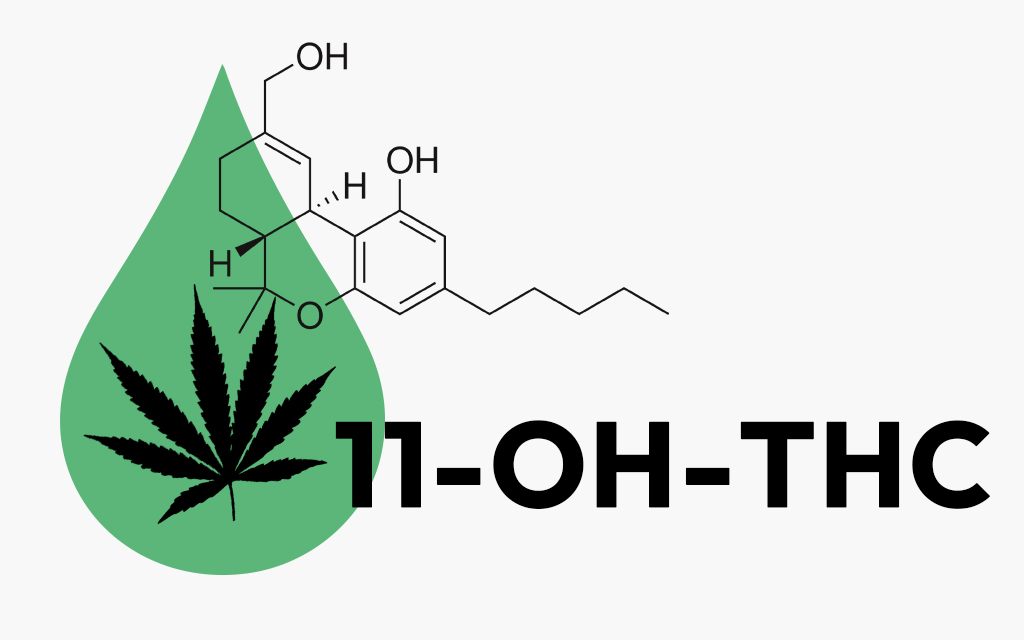Researchers have discovered that the primary metabolite of THC remains potent based on data from mouse models. New research data suggest that the main THC metabolite lingering in urine and blood may still be active and as effective as THC, if not more so. This new finding raises more questions than it answers. According to a recent study published in the Journal of Pharmacology and Experimental Therapeutics, the psychoactive metabolite of THC, 11-hydroxy-THC (11-OH-THC), has equal or greater psychoactive potency than THC (Delta-9 THC).
The study, titled “The Intoxication Equivalence of 11-Hydroxy-Delta-9-THC (11-OH-THC) Relative to Delta-9-THC,” demonstrates how THC metabolites retain activity. It is well known that THC breaks down and generates new intriguing compounds when it decarboxylates and acts in the human body. “In this study, we determined that the primary metabolite of THC, 11-OH-THC, exhibits equal or greater activity than THC in a mouse cannabinoid activity model when directly administered, even considering differences in administration routes, sex, pharmacokinetics, and pharmacodynamics,” the study states. “These data provide crucial insights into the biological activity of THC metabolites, inform future cannabinoid research, and model how THC intake and metabolism affect human cannabis use.”
This research was conducted by a team from Saskatchewan, Canada, including Ayat Zagzoog, Kenzie Halter, Alayna M. Jones, Nicole Bannatyne, Joshua Cline, Alexis Wilcox, Anna-Maria Smolyakova, and Robert B. Laprairie. In the experiment, researchers injected male rats with 11-hydroxy-THC and observed and studied the effects of this THC metabolite compared to its parent compound, Delta-9 THC.
The researchers further noted: “These data indicate that in the tail-flick test for pain perception, the activity of 11-OH-THC is 153% that of THC, and in the catalepsy test, the activity of 11-OH-THC is 78% that of THC. Therefore, even considering pharmacokinetic differences, 11-OH-THC exhibits comparable or even greater activity than its parent compound THC.”
Thus, the study suggests that the THC metabolite 11-OH-THC may play a crucial role in the biological activity of cannabis. Understanding its activity when directly administered will help explain future animal and human studies. The report mentions that 11-OH-THC is one of the two primary metabolites formed after cannabis consumption, the other being 11-nor-9-carboxy-THC, which is not psychoactive but may remain in the blood or urine for a long time.
According to the U.S. Centers for Disease Control and Prevention (CDC), as early as the 1980s, urine tests primarily targeted 11-nor-delta-9-THC-9-carboxylic acid (9-carboxy-THC), a metabolite of Delta-9-THC, which is the main active ingredient in cannabis.
The report points out that although smoking cannabis typically produces effects faster than consuming cannabis edibles, the amount of 11-OH-THC produced through ingestion is greater than that from smoking cannabis flowers. The report suggests that this is one reason why cannabis-infused foods can become more psychoactive and cause confusion for the unprepared.
THC Metabolites and Drug Testing
Evidence shows that cannabis affects users differently depending on the route of administration. A 2021 study published in the Permanent Journal indicated that the effects of consuming cannabis edibles are greater than those of smoking cannabis due to the metabolism of 11-OH-THC.
“The bioavailability of THC through vaporization is 10% to 35%,” the researchers wrote. “After absorption, THC enters the liver, where most of it is eliminated or metabolized into 11-OH-THC or 11-COOH-THC, with the remaining THC and its metabolites entering the bloodstream. Through oral ingestion, the bioavailability of THC is only 4% to 12%. However, due to its high lipophilicity, THC is rapidly absorbed by fat tissues. Typically, the plasma half-life of THC in occasional users is 1 to 3 days, while in chronic users, it can be as long as 5 to 13 days.”
Studies show that long after the psychoactive effects of cannabis have worn off, THC metabolites like 11-OH-THC can remain in the blood and urine for extended periods. This poses challenges for standard methods of testing whether drivers and athletes are impaired due to cannabis use. For example, Australian researchers have been trying to determine the time frame during which cannabis might impair driving performance. In one case, Thomas R. Arkell, Danielle McCartney, and Iain S. McGregor from the Lambert Initiative at the University of Sydney studied the impact of cannabis on driving ability. The team determined that cannabis impairs driving ability for several hours after smoking, but these impairments end before THC metabolites are cleared from the blood, with metabolites persisting in the body for weeks or months.
“Patients using THC-containing products should avoid driving and other safety-sensitive tasks (e.g., operating machinery), especially during the initial treatment period and for several hours after each dose,” the authors wrote. “Even if patients do not feel impaired, they may still test positive for THC. Moreover, medical cannabis patients are currently not exempt from roadside mobile drug testing and related legal sanctions.”
This new research on 11-OH-THC indicates that more studies are needed to deeply understand how THC metabolites affect the human body. Only through continuous efforts can we fully uncover the secrets of these unique compounds.
Post time: Mar-21-2025





